Kristine Hughes's Blog, page 130
March 4, 2012
For Our Fellow Bibliophiles
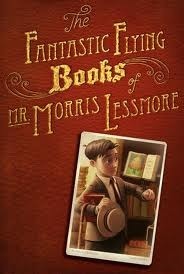
The Fantastic Flying Books of Mr. Morris Lessmore
*Thanks to Nina Dee (Davis) for bringing this to our attention and
congratulations to the producers on winning an Oscar!
By the way, there's an interactive app for this, too!
Published on March 04, 2012 23:45
March 3, 2012
Death of Lady Jersey in 1867
The March 1867 issue of The Gentleman's Magazine carried an obituary for Sarah Sophia Fane Child-Villiers, dowager Countess of Jersey:
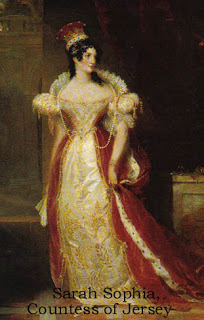
January 26 At 38 Berkeley Square, suddenly by the rupture of a blood vessel, aged 81, Sarah Sophia, Dowager Countess of Jersey.
Her ladyship was the eldest and only surviving child of John, 10th Earl of Westmorland, by Anne, only daughter and heir of Mr. Robert Child. She was born March 4, 1785 and in May 1804 she married George, Viscount Villiers, who in the following year succeeded his father the 5th Earl of Jersey, and by whom she had a family of four sons and three daughters. Her eldest son, George Augustus Frederick, died three weeks after the death of his father in 1859; and was the father of Victor, 7th Earl; Augustus John died at Rome in 1847; Frederick married to Lady Elizabeth, daughter of the 8th Earl of Athlonel (title extinct); Francis John died in May 1862; Lady Sarah, married to Prince Nicholas Esterhazy, son of his Excellency the late Prince, many years an ambassador to the Court of St. James's, from Austria, died at Torquay in November 1853; Lady Clementia died unmarried in December 1858, and Lady Adela, wife of Lieut. Colonel Charles Ibbetson, who died suddenly in September 1860.
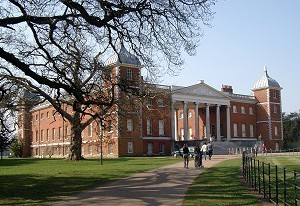 Osterley Park, Greater London
Osterley Park, Greater London
The late countess, on the death of her maternal grandfather, Mr. Robert Child, the banker, by his will succeeded to his large property, both real and personal. Owing to her mother having eloped with the Earl of Westmorland, Mr. Child carried out his determination that not a shilling of his property should go to the male heirs of the earldom, and he bequeathed his large and valuable property to the county of Middlesex and his interest in the old banking house at Temple Bar to the countess. The deceased Lady Jersey was kind and charitable to the poor, but studiously avoided publicity in doing good to those beneath her. Many indigent families will regret her death, as well as an extensive circle of friends.
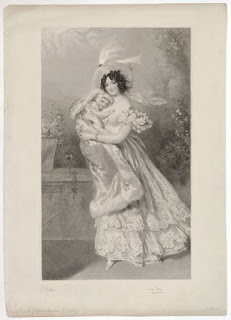 Lady Jersey, National Portrait Galleryby Frederick Christian Lewis Sr, after Alfred Edward Chalonstipple engraving, published 1839
Lady Jersey, National Portrait Galleryby Frederick Christian Lewis Sr, after Alfred Edward Chalonstipple engraving, published 1839
The Countess of Jersey was for many years one of the leading ladies patronesses of "Almacks" and with Viscountess Palmerston shared the greatest influence; indeed she had for more than half a century occupied the highest position in London society. She was a woman of extraordinary abilities and no female member of the aristocracy could surpass her in her knowledge of European politics. For nearly fifty years her saloons were nightly open to receive the distinguished foreign diplomatists of the day and the prominent political character of the Tory and Conservative party. The countess's "at homes" were however, unlike those of Devonshire and Holland houses, exclusively confined to a distinct political faction. Lord Brougham was a great personal friend of the deceased lady, and Viscount Palmerston was among her occasional visitors, even while in office. Lady Jersey was connected by marriage with the late Viscount Ponsonby, the late Marquis of Anglesey; the Earl of Bessborough and a large number of friends of opposite politics.
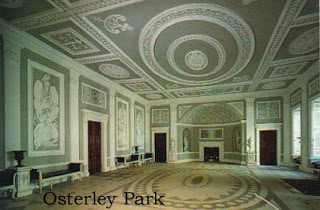 Entrance Hall, NT
Entrance Hall, NT
It was not until the death of her husband in October 1859, that Lady Jersey retired into comparative seclusion.—That is to say, sought only the society of her most intimate friends. The Countess was honoured by the personal regard of the late Emperor Nicholas, the late Kings of Hanover, Prussia, Holland, Belgium, and of George IV when Prince Regent.
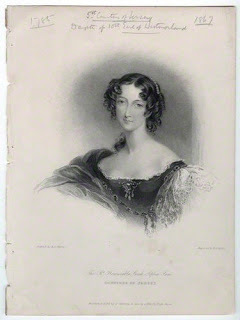 Lady Jersey, National Portrait Galleryby Henry Thomas Ryall, published by John Murray, sold by Charles Tilt, after Edmund Thomas Parris stipple engraving, published 1833
Lady Jersey, National Portrait Galleryby Henry Thomas Ryall, published by John Murray, sold by Charles Tilt, after Edmund Thomas Parris stipple engraving, published 1833
The interment of the deceased took place in the family vault of the parish church of Middleton Stoney, Oxon on the 2d of February, the body of the Countess having been brought to Middleton Park on the day previous. The funeral procession was preceded by the principal tenancy of the estates.
Note from Victoria: The Jersey estate at Middleton, Oxfordshire, was the family's principal country home after its purchase in 1737, though the property had been a manor since the 13th century. The house built there in the 1750's and used by Sarah, Lady Jersey, for extensive entertaining, was pulled down in 1934 and replaced a few years later with a modern house designed by Sir Edward Lutyens, now made into flats. The former Middleton Park grounds are now mostly a public park. The village of Middleton Stoney boasts one public house, the Jersey Arms.[image error]

January 26 At 38 Berkeley Square, suddenly by the rupture of a blood vessel, aged 81, Sarah Sophia, Dowager Countess of Jersey.
Her ladyship was the eldest and only surviving child of John, 10th Earl of Westmorland, by Anne, only daughter and heir of Mr. Robert Child. She was born March 4, 1785 and in May 1804 she married George, Viscount Villiers, who in the following year succeeded his father the 5th Earl of Jersey, and by whom she had a family of four sons and three daughters. Her eldest son, George Augustus Frederick, died three weeks after the death of his father in 1859; and was the father of Victor, 7th Earl; Augustus John died at Rome in 1847; Frederick married to Lady Elizabeth, daughter of the 8th Earl of Athlonel (title extinct); Francis John died in May 1862; Lady Sarah, married to Prince Nicholas Esterhazy, son of his Excellency the late Prince, many years an ambassador to the Court of St. James's, from Austria, died at Torquay in November 1853; Lady Clementia died unmarried in December 1858, and Lady Adela, wife of Lieut. Colonel Charles Ibbetson, who died suddenly in September 1860.
 Osterley Park, Greater London
Osterley Park, Greater LondonThe late countess, on the death of her maternal grandfather, Mr. Robert Child, the banker, by his will succeeded to his large property, both real and personal. Owing to her mother having eloped with the Earl of Westmorland, Mr. Child carried out his determination that not a shilling of his property should go to the male heirs of the earldom, and he bequeathed his large and valuable property to the county of Middlesex and his interest in the old banking house at Temple Bar to the countess. The deceased Lady Jersey was kind and charitable to the poor, but studiously avoided publicity in doing good to those beneath her. Many indigent families will regret her death, as well as an extensive circle of friends.
 Lady Jersey, National Portrait Galleryby Frederick Christian Lewis Sr, after Alfred Edward Chalonstipple engraving, published 1839
Lady Jersey, National Portrait Galleryby Frederick Christian Lewis Sr, after Alfred Edward Chalonstipple engraving, published 1839The Countess of Jersey was for many years one of the leading ladies patronesses of "Almacks" and with Viscountess Palmerston shared the greatest influence; indeed she had for more than half a century occupied the highest position in London society. She was a woman of extraordinary abilities and no female member of the aristocracy could surpass her in her knowledge of European politics. For nearly fifty years her saloons were nightly open to receive the distinguished foreign diplomatists of the day and the prominent political character of the Tory and Conservative party. The countess's "at homes" were however, unlike those of Devonshire and Holland houses, exclusively confined to a distinct political faction. Lord Brougham was a great personal friend of the deceased lady, and Viscount Palmerston was among her occasional visitors, even while in office. Lady Jersey was connected by marriage with the late Viscount Ponsonby, the late Marquis of Anglesey; the Earl of Bessborough and a large number of friends of opposite politics.
 Entrance Hall, NT
Entrance Hall, NTIt was not until the death of her husband in October 1859, that Lady Jersey retired into comparative seclusion.—That is to say, sought only the society of her most intimate friends. The Countess was honoured by the personal regard of the late Emperor Nicholas, the late Kings of Hanover, Prussia, Holland, Belgium, and of George IV when Prince Regent.
 Lady Jersey, National Portrait Galleryby Henry Thomas Ryall, published by John Murray, sold by Charles Tilt, after Edmund Thomas Parris stipple engraving, published 1833
Lady Jersey, National Portrait Galleryby Henry Thomas Ryall, published by John Murray, sold by Charles Tilt, after Edmund Thomas Parris stipple engraving, published 1833The interment of the deceased took place in the family vault of the parish church of Middleton Stoney, Oxon on the 2d of February, the body of the Countess having been brought to Middleton Park on the day previous. The funeral procession was preceded by the principal tenancy of the estates.
Note from Victoria: The Jersey estate at Middleton, Oxfordshire, was the family's principal country home after its purchase in 1737, though the property had been a manor since the 13th century. The house built there in the 1750's and used by Sarah, Lady Jersey, for extensive entertaining, was pulled down in 1934 and replaced a few years later with a modern house designed by Sir Edward Lutyens, now made into flats. The former Middleton Park grounds are now mostly a public park. The village of Middleton Stoney boasts one public house, the Jersey Arms.[image error]
Published on March 03, 2012 01:00
March 1, 2012
Naturalist's Diary for March
From the Times Telescope, an annual almanac, here is the entry for March, 1826, with a few quite optimistic pictures:
March, though the hours of promise with bright rayMay gild thy noons, yet, on wild pinion borne,
Loud winds more often rudely wake thy morn,
And harshly hymn they early-closing day.

The cutting blasts of March, so trying to the invalid, are equally injurious to the progress of vegetation; and the 'sweet flowers' are compelled to await the smiles and tears of gentle April to encourage their growth, and to bring them to perfection. Some more bold than the rest, who dare to brave the warrior front of Boreas, often perish in his chilly embrace. The winds of March, however, are highly beneficial to drying up the superabundant moisture of the earth; and although they may retard the delights and beauties of Spring, these are rendered more valuable to us, because they are less fugacious.

The russet-brown dress of the hedges is now spotted with green, preparatory to their assuming the complete vesture of Spring.—The leaves of the lilac begin to peep from beneath their winter clothing, and gooseberry and currant trees display their verdant foliage and pretty green blossoms. The yew-tree, 'faithful in death,' as it protects our tombs from the gaze of every passing stranger, when our more gaudy floral acquaintances have deserted us, opens its blossoms about the beginning of this month.
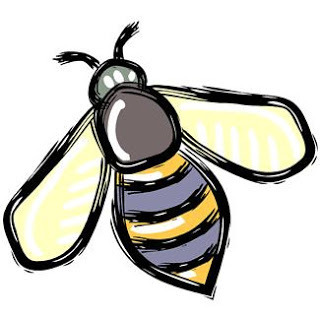
The melody of birds now gradually swells upon the ear. The throstle, second only to the nightingale in song, charms us with the sweetness, and variety of its lays. The linnet and goldfinch join the general concert in this month, and the golden-crowned wren begins its song. The lark also, must not be forgotten.—While the birds delight us with their song, the bees read us a lesson of industry, for they are to be seen collecting materials for their elegant condiment of honey on every fine day throughout the year.
 Goldfinch
Goldfinch
Each succeeding week pours forth fresh beauties from the lap of Flora, and furnishes the botanist with new sources of delight. Golden tufts of crocuses, expending their corollas to receive the genial warmth of the sun, interspersed with pink and blue hepaticas, and the garden daisy, with its little tufts of crimson velvet, united with the blossoms of last month, greatly ornament our flower borders. The alpine wall-cress is still in bloom; the mezereon puts forth its leaves; and the primrose peeps from the retreating snows of winter: it forms a happy shade of distinction between the delicate snowdrop and the flaming crocus.
Daffodils, yellow auriculas, coltsfoot, with its brilliant golden and sometimes pink or silvery stars, and hounds-tongue, are in blossom about the middle of the month. The American cowslip, with its beautiful rose-coloured blossoms, growing in thick branches in the form of a cone, flowers in March. The charming violet, whose attractions have been the theme of many a poetic effusion, makes her appearance this month, but not in full perfection, for the chill winds of March are not very congenial to the expansion of so delicate a blossom.
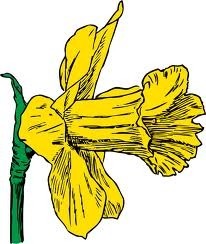
If the weather be mild, the rich hyacinth, the noble descendant of the modest harebell—the sweet narcissus, delicately pale, and some of the early tulips, are now in bloom. The peach and the nectarine begin to show their elegant blossoms.
Protected from inclemency of the weather by our green-houses, roses, hyacinths, heliotropes, and geraniums, are now in full blossom, regaling the senses with their varied hues and rich perfumes.
In this month, black ants are observed; the black-bird and the turkey law; the house pigeons sit. The greenfinch sings; the bat is seen flitting about; and the viper uncoils itself from its winter sleep. The wheatear, or English ortolan (Sylvia oenanthe) again pays its annual visit, leaving England in September. Those birds which have passed the winter in England now take their departure for more northerly regions; as the fieldfare, the red-wing, and the wood-cock.
On the 20th, the vernal equinox takes place, and all nature feels her renovating sway, and seems to rejoice at the retreat of winter.
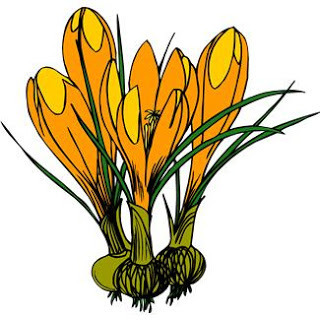
The general or great flow of sap in most trees takes place in this month; this is preparatory to the expanding of the leaves and ceases when they are out. The ash now puts forth its grey buds; and the hazel and willow exhibit some signs of returning life in their silky, enfolding catkins. The leaves of the thornless rose and of the hawthorn are gradually becoming determinate. The field daisy is now seen scattered over dry pastures. This pretty flower, the poet's darling, from Chaucer to Wordsworth and Montgomery, has claimed for itself many an elegant tribute.
The planting and sowing of Forest Trees is generally concluded in this month. The mixing of fir-trees with oaks (except in very sheltered situations) is now frequently adopted by the planter.

In March, trouts begin to rise, and blood worms appear in the water. The clay hair worms is found at the bottom of the drains and ditches, and the water-flea may be seen gliding about upon the surface of sheltered pools. Bats now issue from their places of concealment. Peas appear above ground; the sea-kale (Crambe maritima) begins to sprout. The male blossoms of the yew-tree expand and discharge their farina. Sparrows are busily employed in forming their nests. Young otters are produced, and young lambs are yeaned this month.
The equinoctial gales are usually most felt, both by sea and land, about this time.
The brimstone-coloured butterfly (Gonepteryx rhamni) which lives throughout the winter, is usually seen in March. It is found in the neighbourhood woods, on fine and warm days, enjoying the beams of the noonday sun. Some of our most beautiful butterflies, belonging to the genus Vanessa, as V. atalanta, Io, Polylcholoros, and Urticae, are seen in this month; and the Antiopa, or Camberwell beauty, has once been captured at this season.


March, though the hours of promise with bright rayMay gild thy noons, yet, on wild pinion borne,
Loud winds more often rudely wake thy morn,
And harshly hymn they early-closing day.

The cutting blasts of March, so trying to the invalid, are equally injurious to the progress of vegetation; and the 'sweet flowers' are compelled to await the smiles and tears of gentle April to encourage their growth, and to bring them to perfection. Some more bold than the rest, who dare to brave the warrior front of Boreas, often perish in his chilly embrace. The winds of March, however, are highly beneficial to drying up the superabundant moisture of the earth; and although they may retard the delights and beauties of Spring, these are rendered more valuable to us, because they are less fugacious.

The russet-brown dress of the hedges is now spotted with green, preparatory to their assuming the complete vesture of Spring.—The leaves of the lilac begin to peep from beneath their winter clothing, and gooseberry and currant trees display their verdant foliage and pretty green blossoms. The yew-tree, 'faithful in death,' as it protects our tombs from the gaze of every passing stranger, when our more gaudy floral acquaintances have deserted us, opens its blossoms about the beginning of this month.

The melody of birds now gradually swells upon the ear. The throstle, second only to the nightingale in song, charms us with the sweetness, and variety of its lays. The linnet and goldfinch join the general concert in this month, and the golden-crowned wren begins its song. The lark also, must not be forgotten.—While the birds delight us with their song, the bees read us a lesson of industry, for they are to be seen collecting materials for their elegant condiment of honey on every fine day throughout the year.
 Goldfinch
GoldfinchEach succeeding week pours forth fresh beauties from the lap of Flora, and furnishes the botanist with new sources of delight. Golden tufts of crocuses, expending their corollas to receive the genial warmth of the sun, interspersed with pink and blue hepaticas, and the garden daisy, with its little tufts of crimson velvet, united with the blossoms of last month, greatly ornament our flower borders. The alpine wall-cress is still in bloom; the mezereon puts forth its leaves; and the primrose peeps from the retreating snows of winter: it forms a happy shade of distinction between the delicate snowdrop and the flaming crocus.
Daffodils, yellow auriculas, coltsfoot, with its brilliant golden and sometimes pink or silvery stars, and hounds-tongue, are in blossom about the middle of the month. The American cowslip, with its beautiful rose-coloured blossoms, growing in thick branches in the form of a cone, flowers in March. The charming violet, whose attractions have been the theme of many a poetic effusion, makes her appearance this month, but not in full perfection, for the chill winds of March are not very congenial to the expansion of so delicate a blossom.

If the weather be mild, the rich hyacinth, the noble descendant of the modest harebell—the sweet narcissus, delicately pale, and some of the early tulips, are now in bloom. The peach and the nectarine begin to show their elegant blossoms.
Protected from inclemency of the weather by our green-houses, roses, hyacinths, heliotropes, and geraniums, are now in full blossom, regaling the senses with their varied hues and rich perfumes.
In this month, black ants are observed; the black-bird and the turkey law; the house pigeons sit. The greenfinch sings; the bat is seen flitting about; and the viper uncoils itself from its winter sleep. The wheatear, or English ortolan (Sylvia oenanthe) again pays its annual visit, leaving England in September. Those birds which have passed the winter in England now take their departure for more northerly regions; as the fieldfare, the red-wing, and the wood-cock.
On the 20th, the vernal equinox takes place, and all nature feels her renovating sway, and seems to rejoice at the retreat of winter.

The general or great flow of sap in most trees takes place in this month; this is preparatory to the expanding of the leaves and ceases when they are out. The ash now puts forth its grey buds; and the hazel and willow exhibit some signs of returning life in their silky, enfolding catkins. The leaves of the thornless rose and of the hawthorn are gradually becoming determinate. The field daisy is now seen scattered over dry pastures. This pretty flower, the poet's darling, from Chaucer to Wordsworth and Montgomery, has claimed for itself many an elegant tribute.
The planting and sowing of Forest Trees is generally concluded in this month. The mixing of fir-trees with oaks (except in very sheltered situations) is now frequently adopted by the planter.

In March, trouts begin to rise, and blood worms appear in the water. The clay hair worms is found at the bottom of the drains and ditches, and the water-flea may be seen gliding about upon the surface of sheltered pools. Bats now issue from their places of concealment. Peas appear above ground; the sea-kale (Crambe maritima) begins to sprout. The male blossoms of the yew-tree expand and discharge their farina. Sparrows are busily employed in forming their nests. Young otters are produced, and young lambs are yeaned this month.
The equinoctial gales are usually most felt, both by sea and land, about this time.
The brimstone-coloured butterfly (Gonepteryx rhamni) which lives throughout the winter, is usually seen in March. It is found in the neighbourhood woods, on fine and warm days, enjoying the beams of the noonday sun. Some of our most beautiful butterflies, belonging to the genus Vanessa, as V. atalanta, Io, Polylcholoros, and Urticae, are seen in this month; and the Antiopa, or Camberwell beauty, has once been captured at this season.

Published on March 01, 2012 01:00
February 28, 2012
Preserved Kitchens from the Past
A few months ago, the Daily Mail reported on the discovery of a Victorian kitchen in the basement of a large home in Wales. The room, closed off for decades, will be preserved as an excellent example of how the servants once lived and worked.
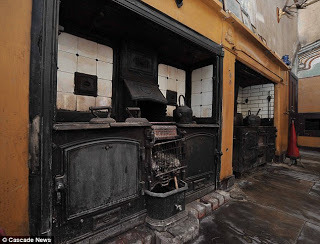 Cefn Park, Wales
Cefn Park, Wales
The entire article is here. Imagine discovering such relics right down in the basement!
Which got us thinking about other historic kitchens we've visited in Britain. There are many -- send us your favorites!
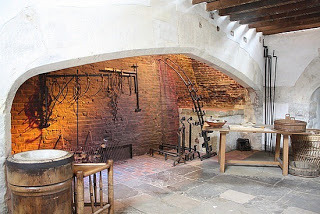
The Hampton Court Palace kitchens are among the most popular parts of the oft-visited palace. On many days, costumed works demonstrate Tudor cookery and prepare treats for the sightseers. We remember imbibing chocolate drinks, far different than what we enjoy at Starbucks, but still delicious (when you get used to it!).
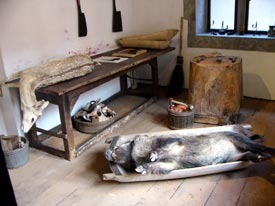
Above, the larder where the butcher received game and began to prepare the meat for feeding the hundreds of royal guests, court functionaries and palace staff. Imagine keeping 600 people fed -- 24/7.
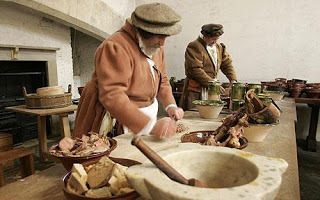
The kitchen complex includes bakeries, breweries, larders, boiling and roasting rooms, pantries, confectories, spicery, and many more. Not to mention sculleries I suppose. For more on Henry VIII's kitchens, click here.
Another wonderful kitchen that prepared royal meals is in the Brighton Pavilion, home of the Prince Regent, later George IV. For a panoramic Tour, click here. For more on the Brighton Pavilion, try this.
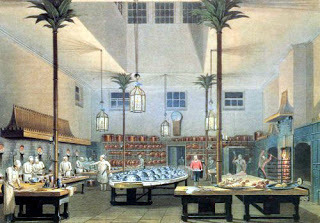
When it was constructed in the early 1800's, it was the epitome of innovation with its high ceilings. Our friend Ian Kelly wrote a book about Careme, the most famous chef who worked here, among other places. For details, click here.
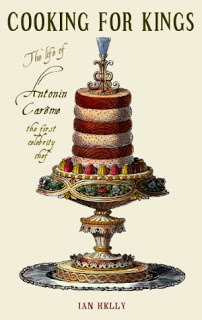
Below, the kitchens at Burghley House, home of Queen Elizabeth I's trusted advisor William Cecil.
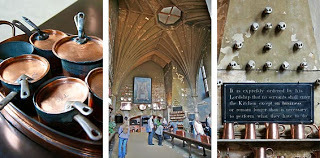
The kitchens at Burghley House are filled with copper pans (Kristine and Victoria and their companions almost swooned at the thought of keeping all of them so shiny!) On the right above, are the collected skulls of turtles, who were no doubt privileged to sacrifice their lives to the soup pot. To see more on Burghley House, click here.
As a matter of fact, displays of gleaming copper pots are typical of the kitchens in stately homes. Petworth has a wonderful collection. Details on Petworth here.
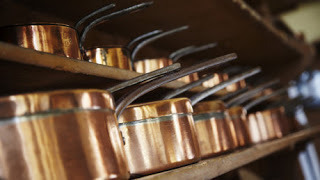 Petworth, National Trust
Petworth, National Trust

Harewood House, above, in Yorkshire also boasts shelf after shelf of bright copper utensils. This kitchen, too, is often the site of special events which include tasty treats. Harewood's excellent website is here.
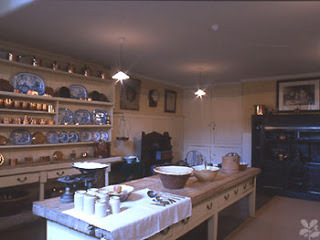 Uppark, NT
Uppark, NT
There's a special twist to the downstairs facilities displayed at the National Trust's Uppark House. The mother of the brilliant author H. G.Wells (1866-1946) worked here as housekeeper in the 1880's and the young Wells grew up in the servants quarters. More on Uppark is here.
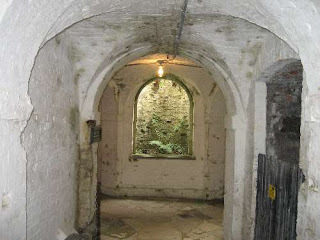
The tunnels at Uppark were constructed to shield the delicate sensibilities of the owners from viewing the servants bustling about between the kitchens and the stables. But imagine how much fun it would be to play hide-and-seek here. Or chase the toads that often invade. Nevertheless, we should not try to romanticize the lives beneath the stairs -- it was never easy and often brutal.
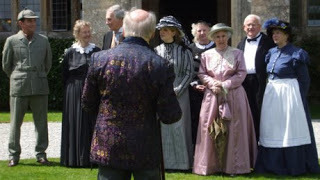
However, if you insist upon romanticizing the life of a servant, you can always try your hand at various below stairs tasks at the very interactive Lanhydrock House (above) in Cornwall, where they urge visitors to "have a go at napkin folding, laying a place setting and hat brushing on our touch and discover tables around the house."
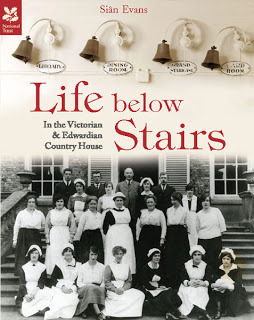
For an authentic look at the life of the country house staff, the National Trust has this and other volumes available at their bookstore, here.
So what are you having for dinner? I'm thinking carry-out!

 Cefn Park, Wales
Cefn Park, WalesThe entire article is here. Imagine discovering such relics right down in the basement!
Which got us thinking about other historic kitchens we've visited in Britain. There are many -- send us your favorites!

The Hampton Court Palace kitchens are among the most popular parts of the oft-visited palace. On many days, costumed works demonstrate Tudor cookery and prepare treats for the sightseers. We remember imbibing chocolate drinks, far different than what we enjoy at Starbucks, but still delicious (when you get used to it!).

Above, the larder where the butcher received game and began to prepare the meat for feeding the hundreds of royal guests, court functionaries and palace staff. Imagine keeping 600 people fed -- 24/7.

The kitchen complex includes bakeries, breweries, larders, boiling and roasting rooms, pantries, confectories, spicery, and many more. Not to mention sculleries I suppose. For more on Henry VIII's kitchens, click here.
Another wonderful kitchen that prepared royal meals is in the Brighton Pavilion, home of the Prince Regent, later George IV. For a panoramic Tour, click here. For more on the Brighton Pavilion, try this.

When it was constructed in the early 1800's, it was the epitome of innovation with its high ceilings. Our friend Ian Kelly wrote a book about Careme, the most famous chef who worked here, among other places. For details, click here.

Below, the kitchens at Burghley House, home of Queen Elizabeth I's trusted advisor William Cecil.

The kitchens at Burghley House are filled with copper pans (Kristine and Victoria and their companions almost swooned at the thought of keeping all of them so shiny!) On the right above, are the collected skulls of turtles, who were no doubt privileged to sacrifice their lives to the soup pot. To see more on Burghley House, click here.
As a matter of fact, displays of gleaming copper pots are typical of the kitchens in stately homes. Petworth has a wonderful collection. Details on Petworth here.
 Petworth, National Trust
Petworth, National Trust
Harewood House, above, in Yorkshire also boasts shelf after shelf of bright copper utensils. This kitchen, too, is often the site of special events which include tasty treats. Harewood's excellent website is here.
 Uppark, NT
Uppark, NTThere's a special twist to the downstairs facilities displayed at the National Trust's Uppark House. The mother of the brilliant author H. G.Wells (1866-1946) worked here as housekeeper in the 1880's and the young Wells grew up in the servants quarters. More on Uppark is here.

The tunnels at Uppark were constructed to shield the delicate sensibilities of the owners from viewing the servants bustling about between the kitchens and the stables. But imagine how much fun it would be to play hide-and-seek here. Or chase the toads that often invade. Nevertheless, we should not try to romanticize the lives beneath the stairs -- it was never easy and often brutal.

However, if you insist upon romanticizing the life of a servant, you can always try your hand at various below stairs tasks at the very interactive Lanhydrock House (above) in Cornwall, where they urge visitors to "have a go at napkin folding, laying a place setting and hat brushing on our touch and discover tables around the house."

For an authentic look at the life of the country house staff, the National Trust has this and other volumes available at their bookstore, here.
So what are you having for dinner? I'm thinking carry-out!
Published on February 28, 2012 01:00
February 26, 2012
More Reminiscences of Captain Gronow
To say that Captain Gronow is not politically correct by today's standards would be an understatement indeed. However, his comments no doubt reflect the prevailing view of his readers, however offensive we find his prejudices today.
Here are Gronow's observations on author Matthew Lewis (1775-1818), known as Monk after the name of his renowned Gothick novel.
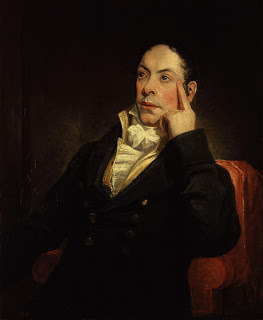 Matthew "Monk" Lewis by Pickersgill, 1809
Matthew "Monk" Lewis by Pickersgill, 1809
"MONK" LEWIS
One of the most agreeable men of the day was "Monk" Lewis. As the author of the Monk and the Tales of Wonder, he not only found his way into the best circles, but had gained a high reputation in the literary world. His poetic talent was undoubted, and he was intimately connected with Walter Scott in his ballad researches. His Alonzo the Brave and the Fair Imogene was recited at the theatres, and wherever he went he found a welcome reception. His West Indian fortune and connections, and his seat in Parliament, gave him access to all the aristocratic circles; from which, however, he was banished upon the appearance of the fourth and last dialogue of the Pursuits of Literature. Had a thunderbolt fallen upon him, he could not have been more astonished than he was by the onslaught of Mr. Matthias, which led to his ostracism from fashionable society.
It is not for me to appreciate the value of this satirical poem, which created such an extraordinary sensation, not only in the fashionable, but in the political world; I, however, remember that whilst at Canning's, at the Bishop of London's, and at Gifford's, it was pronounced the most classical and spirited production that had ever issued from the press, it was held up at Lord Holland's, at the Marquis of Lansdowne's, and at Brookes's, as one of the most spiteful and ill-natured satires that had ever disgraced the literary world; and one which no talent or classic lore could ever redeem. Certain it is, that Matthias fell foul of poor "Monk" Lewis for his romance: obscenity and blasphemy were the charges laid at his door; he was acknowledged to be a man of genius and fancy, but this added only to his crime, to which was superadded that of being a very young man. The charges brought against him cooled his friends and heated his enemies; the young ladies were forbidden to speak to him, matrons even feared him, and from being one of the idols of the world, he became one of the objects of its disdain. Even his father was led to believe that his son had abandoned the paths of virtue, and was on the high road to ruin.
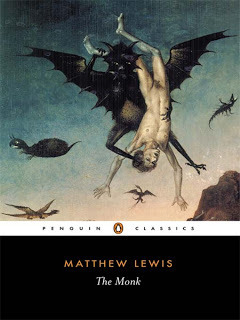
"Monk" Lewis, unable to stand against the outcry thus raised against him, determined to try the effects of absence, and took his departure for the island in which his property was; but unfortunately for those who dissented from the ferocious judgment that was passed upon him, and for those who had discrimination enough to know that after all there was nothing very objectionable in his romance, and felt assured that posterity would do him justice, this amiable and kind-hearted man died on his passage out; leaving a blank in one variety of literature which has never been filled up.
The denunciation was not followed by any other severe criticism; but editors have, in compliance with the insinuations of Matthias, omitted the passages which he pointed out as objectionable, so that the original text is seldom met with.
"Monk" Lewis had a black servant, affectionately attached to his master; but so ridiculously did this servant repeat his master's expressions, that he became the laughing-stock of all his master's friends: Brummell used often to raise a hearty laugh at Carlton House by repeating witticisms which he pretended to have heard from Lewis's servant. Some of these were very stale; yet they were considered so good as to be repeated at the clubs, greatly adding to the reputation of the Beau as a teller of good things. "On one occasion," said Brummell, "I called to inquire after a young lady who had sprained her ancle; Lewis, on being asked how she was, had said in the black's presence, 'The doctor has seen her, put her legs straight, and the poor chicken is doing well.' The servant, therefore, told me, with a mysterious and knowing look, 'Oh, sir, the doctor has been here; she has laid eggs, and she and the chickens are doing well.'"
Such extravagances in those days were received as the essence of wit, and to such stories did the public give a willing ear, repeating them with unwearying zest. Even Sheridan's wit partook of this character, making him the delight of the Prince, who ruled over the fashionable world, and whose approbation was sufficient to give currency to anything, however ludicrous and absurd.
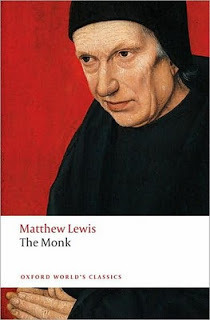

Here are Gronow's observations on author Matthew Lewis (1775-1818), known as Monk after the name of his renowned Gothick novel.
 Matthew "Monk" Lewis by Pickersgill, 1809
Matthew "Monk" Lewis by Pickersgill, 1809"MONK" LEWIS
One of the most agreeable men of the day was "Monk" Lewis. As the author of the Monk and the Tales of Wonder, he not only found his way into the best circles, but had gained a high reputation in the literary world. His poetic talent was undoubted, and he was intimately connected with Walter Scott in his ballad researches. His Alonzo the Brave and the Fair Imogene was recited at the theatres, and wherever he went he found a welcome reception. His West Indian fortune and connections, and his seat in Parliament, gave him access to all the aristocratic circles; from which, however, he was banished upon the appearance of the fourth and last dialogue of the Pursuits of Literature. Had a thunderbolt fallen upon him, he could not have been more astonished than he was by the onslaught of Mr. Matthias, which led to his ostracism from fashionable society.
It is not for me to appreciate the value of this satirical poem, which created such an extraordinary sensation, not only in the fashionable, but in the political world; I, however, remember that whilst at Canning's, at the Bishop of London's, and at Gifford's, it was pronounced the most classical and spirited production that had ever issued from the press, it was held up at Lord Holland's, at the Marquis of Lansdowne's, and at Brookes's, as one of the most spiteful and ill-natured satires that had ever disgraced the literary world; and one which no talent or classic lore could ever redeem. Certain it is, that Matthias fell foul of poor "Monk" Lewis for his romance: obscenity and blasphemy were the charges laid at his door; he was acknowledged to be a man of genius and fancy, but this added only to his crime, to which was superadded that of being a very young man. The charges brought against him cooled his friends and heated his enemies; the young ladies were forbidden to speak to him, matrons even feared him, and from being one of the idols of the world, he became one of the objects of its disdain. Even his father was led to believe that his son had abandoned the paths of virtue, and was on the high road to ruin.

"Monk" Lewis, unable to stand against the outcry thus raised against him, determined to try the effects of absence, and took his departure for the island in which his property was; but unfortunately for those who dissented from the ferocious judgment that was passed upon him, and for those who had discrimination enough to know that after all there was nothing very objectionable in his romance, and felt assured that posterity would do him justice, this amiable and kind-hearted man died on his passage out; leaving a blank in one variety of literature which has never been filled up.
The denunciation was not followed by any other severe criticism; but editors have, in compliance with the insinuations of Matthias, omitted the passages which he pointed out as objectionable, so that the original text is seldom met with.
"Monk" Lewis had a black servant, affectionately attached to his master; but so ridiculously did this servant repeat his master's expressions, that he became the laughing-stock of all his master's friends: Brummell used often to raise a hearty laugh at Carlton House by repeating witticisms which he pretended to have heard from Lewis's servant. Some of these were very stale; yet they were considered so good as to be repeated at the clubs, greatly adding to the reputation of the Beau as a teller of good things. "On one occasion," said Brummell, "I called to inquire after a young lady who had sprained her ancle; Lewis, on being asked how she was, had said in the black's presence, 'The doctor has seen her, put her legs straight, and the poor chicken is doing well.' The servant, therefore, told me, with a mysterious and knowing look, 'Oh, sir, the doctor has been here; she has laid eggs, and she and the chickens are doing well.'"
Such extravagances in those days were received as the essence of wit, and to such stories did the public give a willing ear, repeating them with unwearying zest. Even Sheridan's wit partook of this character, making him the delight of the Prince, who ruled over the fashionable world, and whose approbation was sufficient to give currency to anything, however ludicrous and absurd.

Published on February 26, 2012 01:01
February 24, 2012
More excerpts from Captain Gronow's Reminiscences
Captain Gronow knew and admired the Austrian dancer Fanny Elssler (1810-1884). Here, from his Reminiscences, is his commentary on her:
FANNY ELSSLER
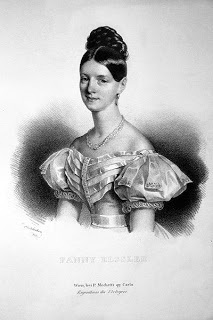
In 1822 I saw this beautiful person for the first time. She was originally one of the figurantes at the opera at Vienna, and was at this time about fourteen years of age, and of delicate and graceful proportions. Her hair was auburn, her eyes blue and large, and her face wore an expression of great tenderness. Some years after the Duke of Reichstadt, the son of the great Napoleon, was captivated with her beauty; in a word, he became her acknowledged admirer, while her marvellous acting and dancing drew around her all the great men of the German court. The year following she went to Naples, where a brother of the King fell desperately in love with her. Mademoiselle Elssler went soon afterwards to Paris, where her wit electrified all the fashionable world, and her dancing and acting in the Diable Boiteux made the fortune of the entrepreneur. In London her success was not so striking; but her cachucha will long be remembered, as one of the most exquisite exhibitions of female grace and power ever seen at her Majesty's Theatre, and in expressiveness, her pantomimic powers were unrivalled.
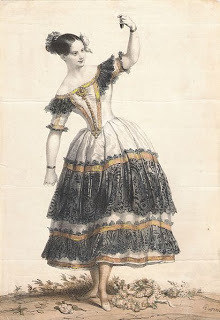 Fanny Elssler, 1836
Fanny Elssler, 1836

FANNY ELSSLER

In 1822 I saw this beautiful person for the first time. She was originally one of the figurantes at the opera at Vienna, and was at this time about fourteen years of age, and of delicate and graceful proportions. Her hair was auburn, her eyes blue and large, and her face wore an expression of great tenderness. Some years after the Duke of Reichstadt, the son of the great Napoleon, was captivated with her beauty; in a word, he became her acknowledged admirer, while her marvellous acting and dancing drew around her all the great men of the German court. The year following she went to Naples, where a brother of the King fell desperately in love with her. Mademoiselle Elssler went soon afterwards to Paris, where her wit electrified all the fashionable world, and her dancing and acting in the Diable Boiteux made the fortune of the entrepreneur. In London her success was not so striking; but her cachucha will long be remembered, as one of the most exquisite exhibitions of female grace and power ever seen at her Majesty's Theatre, and in expressiveness, her pantomimic powers were unrivalled.
 Fanny Elssler, 1836
Fanny Elssler, 1836
Published on February 24, 2012 01:00
February 21, 2012
The Wellington Connection: Waterloo Chairs
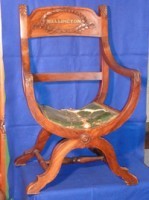
Discovered during a routine valuation morning at the Chipping Norton branch of Tayler and Fletcher, Auctioneer and Valuer Stephen Sheppard could not believe his eyes when a photograph of The Duke of Wellington Chair appeared before him. This fine regency period elm cross frame chair proudly proclaimed the name 'Wellington' in bold brass lettering to the top rail and carried a metal plate inscribed with the following inscription 'This chair is formed from a tree which grew on the plains of Waterloo, and under which the Duke of Wellington stood during a great portion of the day on which he achieved the most glorious of his many Victories. The wood was given to me by J G Children Esq., of The B. Museum, who purchased the entire tree of its proprietor E.V.U.'
Field Marshal Arthur Wellesley, 1st Duke of Wellington, KG, GCB, GCH, PC, FRS (1 May 1769 - 14 September 1852), was a British soldier and statesman, a native of Ireland, from the Anglo-Irish Ascendancy and one of the leading military and political figures of the nineteenth century. He is often referred to as the 'Duke of Wellington,' even after his death and there have been subsequent Dukes of Wellington.
Wellington rose to prominence as a general during the Peninsular campaign of the Napoleonic Wars, and was promoted to the rank of field marshal after leading the allied forces to victory against the French at the Battle of Victorian in 1813. Following Napoleon's exile in 1814, he served as the ambassador to France and was granted a dukedom. During the Hundred Days war in 1815, he commanded the allied army which, with a Prussian army under Blücher, defeated Napoleon at the Battle of Waterloo. Wellesley's battle record is exemplary, ultimately participating in some 60 battles throughout his military career; he was also twice prime minister under the Tory party and remained Commander-in-Chief of the British Army until his death.
Following further research, it was discovered that The Gentleman's magazine of 1836 carried a contemporary review of Dykes Tour in Belgium - Kay's Caffraria, which states "As to accuracy of fact - Mr Dyke mentions that the elm tree on the plain of Waterloo, under which Lord Wellington stood, "was purchased of a farmer, by a mercenary Goth from England, who hacked and twisted it into tooth picks and snuff boxes". Now the fact is, that this said mercenary Goth was John George Children, Esq. of the British Museum, the learned and scientific translator of Berzelius, who did not cut it into tooth picks or snuff boxes, but formed it into a massive and handsome chair, in which he reposes, and which he does not sell." Could this be the very chair mentioned in the magazine article of 1836? The Wellington Chair is estimated at £5,000-£8,000 and measures 97cm high x 61cm wide. Provenance: Purchased at a country house sale in Oxfordshire during the 1950's thence by descent to the private vendor.
This fine piece of furniture is only one small part of a much larger auction sale that will include ceramics, glassware, metalware and bronzes, silverware, jewellery, clocks watches and barometers, collectables and bijouterie, paintings and pictures, mirrors and books, soft furnishings, textiles and hand knotted oriental rugs and carpets and viewing for this particular auction sale at the Pittville Pump Room, Cheltenham, is on Wednesday the 29th February from 8am-7pm and also on the morning of the sale from 7.30am until the start of sale at 10am. 01451 821666 www.taylerandfletcher.co.uk
Published on February 21, 2012 22:12
February 20, 2012
Review of Eliza O'Neil at Covent Garden
Fom La Belle Assemblee, May, 1815
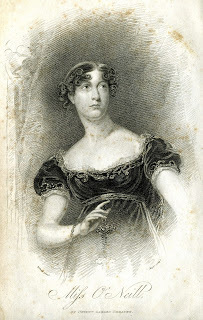
Covent Garden
A new afterpiece, entitled The Fortune of War, was on Wednesday, May 17, performed at this Theatre; it is, without question, one of the most humourous farces of the day. It is the production of Mr Kenny, to whose fertile and whimsical genius the public are indebted for several pieces of acknowledged merit.
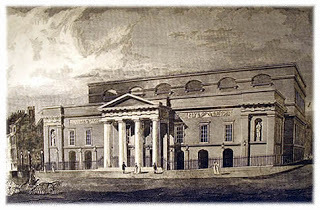 Covent Garden, c. 1815
Covent Garden, c. 1815
The plot, which comprises a far greater number of ludicrous incidents and whimsical situations than we have recently seen in any effort of the same description is remarkable for its complexity.
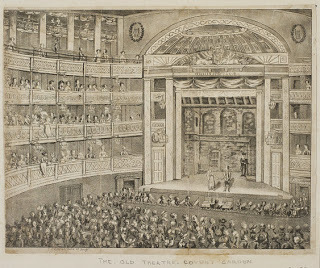 Covent Garden, c. 1815
Covent Garden, c. 1815
The afterpiece met with almost unprecedented success. It was loudly applauded throughout, and was announced for repetition, amidst the exclamations of the audience.
Miss O'Neil's performance of the character of Euphrosia, in the Grecian Daughter, may be ranked amongst her most successful efforts. The play, in many senses, is heavy and declamatory, and wants that spirit and variety of action, without which tragedy never fails to be insipid. In some senses, however, the character of Euphrosia shines forth with great strength and dignity, and rescues this piece from that oblivion into which it would otherwise have fallen. Miss O'Neil was peculiarly successful in the scene with Evander; she threw a surprising pathos and an heroic affection into this scene which we never saw surpassed. In the scene in which she stabs Dionysius she was most eminently happy; she here rose to the highest energy and sublimity of tragic acting, and gave us a lively image of Mrs. Siddons in her best days. Young's Evander was a chaste and powerful performance.
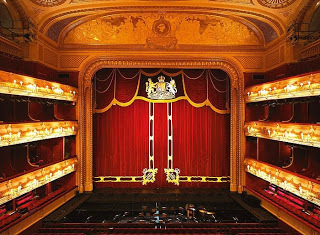 Today's Royal Opera House, Covent Garden
Today's Royal Opera House, Covent Garden


Covent Garden
A new afterpiece, entitled The Fortune of War, was on Wednesday, May 17, performed at this Theatre; it is, without question, one of the most humourous farces of the day. It is the production of Mr Kenny, to whose fertile and whimsical genius the public are indebted for several pieces of acknowledged merit.
 Covent Garden, c. 1815
Covent Garden, c. 1815The plot, which comprises a far greater number of ludicrous incidents and whimsical situations than we have recently seen in any effort of the same description is remarkable for its complexity.
 Covent Garden, c. 1815
Covent Garden, c. 1815The afterpiece met with almost unprecedented success. It was loudly applauded throughout, and was announced for repetition, amidst the exclamations of the audience.
Miss O'Neil's performance of the character of Euphrosia, in the Grecian Daughter, may be ranked amongst her most successful efforts. The play, in many senses, is heavy and declamatory, and wants that spirit and variety of action, without which tragedy never fails to be insipid. In some senses, however, the character of Euphrosia shines forth with great strength and dignity, and rescues this piece from that oblivion into which it would otherwise have fallen. Miss O'Neil was peculiarly successful in the scene with Evander; she threw a surprising pathos and an heroic affection into this scene which we never saw surpassed. In the scene in which she stabs Dionysius she was most eminently happy; she here rose to the highest energy and sublimity of tragic acting, and gave us a lively image of Mrs. Siddons in her best days. Young's Evander was a chaste and powerful performance.
 Today's Royal Opera House, Covent Garden
Today's Royal Opera House, Covent Garden
Published on February 20, 2012 01:00
February 18, 2012
Our Love Affair with Country Life
Intriguing concept? Well, have to admit we are talking about a magazine here. Country Life is a weekly slick publication in the UK to which a few privileged Americans (like Kristine) have subscriptions.
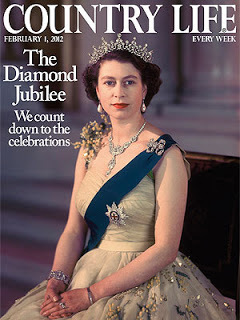 February 1, 2012 issue
February 1, 2012 issue
The website is here. It give a wonderful summary of what is in the magazine -- but to be honest, holding a heavy copy in your hands and turning the glossy pages provides a particular thrill. You will find lots of information and pictures on the website, but give me a fresh issue, a cup of tea, and a hassock on which to rest my feet. Picture a perfectly contented person, dreaming of that perfect house...or ideal estate...or a London pied a terre. And every week, a new source for those dreams.

I assume that the lavish property ads give the magazine its primary income as well as its fantasy factor for those of us who spend hours pretending...would I prefer a townhouse...or an estate on the coast...or in the Yorkshire Dales? A recent issue concentrating on the Cotswolds absolutely gave me palpitations. I simply couldn't choose which one I would focus my dayreams on. I had to read it over and over.
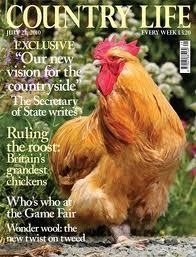
The covers are wonderful, from the Queen to the noble hen above. Or the antique airplane (a Sopwith Camel, c. 1917, I think) below.
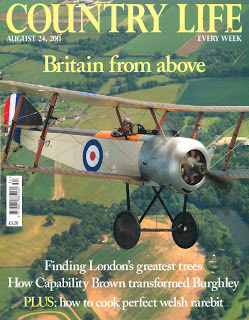
Not only are there wonderful property ads -- you will also find art and antiques, clothing and jewelry, all for the upper crust crowd. But, as I say, we can dream.
The magazine's editorial content is devoted to all the topics that might interest a country gentleman or gentlewoman. They are sometimes unabashedly involved in political issues, taking a rather traditional approach in defending the interests of the countryside in issues such as land use, development, and agricultural and coastline policies.
 Cornish Coast, NT
Cornish Coast, NT
Other articles describe notable gardens and give hints on growing various kinds of plants, both decorative and edible. Or raising dogs, especially sporting and working dogs. Hunting and fishing are often discussed, as is fox-hunting.
Every issue carries a picture of a lovely young lady, sometimes about to be married, other times in business. This has been a feature for many years. I remember reading an Alexander McCall Smith story about a young lady who had been the "girl of the week" and was embarrassed to admit it to her university friends.
Among my favorite features are the stories of stately homes, their preservation and their presentation to the public. It is not hard to imagine what a financial burden these piles are for the families who own them; that is why so many are English Heritage or National Trust.
After I finish my reveries (delusions?) about property, I usually flip to the back page to look at the wonderful cartoon in Tottering -by-Gently, the work of Annie Hurst. For more views, click here.
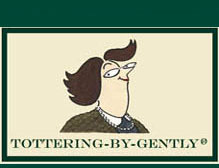
Among my other regular favoites are the columns of the Country Mouse and the Town Mouse, for random observations on life, always amusing and/or thought-provoking.

They even have recipes and restaurant reviews. Below, a suggestion for your next Tea Party.
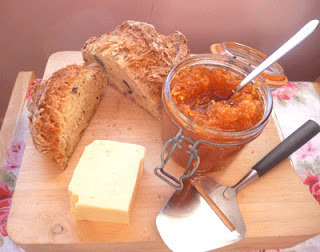 carrot relish recipe
carrot relish recipe
Whatever your favorite magazine feature, you will be entertained and amused by Country Life. We love to read the magazine in an aspirational mood -- for almost everything here is beyond our reach, however much we admire it. It's delicious for wishing!!
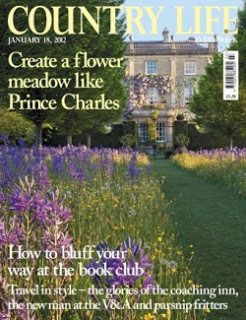
Kristine here, who just finished reading the issue above - the piece on coaching inns was marvelous. My subscription to Country Life is an annual gift that I make to myself and I look forward to its arrival each week. Like Victoria, my favourite bits of the magazine are the real estate ads at the front, some of which I've posted here on the blog. Stately home articles, historic tidbits, recipes, gardening, architectural stories and, of course, the husbandry of various animals all make for a weird yet satisfying combination. Where else would find such articles as "Why the English love their chimneys" and "The quintessential gourmet experience in London" in the same issue? Victoria - I've a new batch of Country Life issues to give you when next we meet.
 February 1, 2012 issue
February 1, 2012 issueThe website is here. It give a wonderful summary of what is in the magazine -- but to be honest, holding a heavy copy in your hands and turning the glossy pages provides a particular thrill. You will find lots of information and pictures on the website, but give me a fresh issue, a cup of tea, and a hassock on which to rest my feet. Picture a perfectly contented person, dreaming of that perfect house...or ideal estate...or a London pied a terre. And every week, a new source for those dreams.

I assume that the lavish property ads give the magazine its primary income as well as its fantasy factor for those of us who spend hours pretending...would I prefer a townhouse...or an estate on the coast...or in the Yorkshire Dales? A recent issue concentrating on the Cotswolds absolutely gave me palpitations. I simply couldn't choose which one I would focus my dayreams on. I had to read it over and over.

The covers are wonderful, from the Queen to the noble hen above. Or the antique airplane (a Sopwith Camel, c. 1917, I think) below.

Not only are there wonderful property ads -- you will also find art and antiques, clothing and jewelry, all for the upper crust crowd. But, as I say, we can dream.
The magazine's editorial content is devoted to all the topics that might interest a country gentleman or gentlewoman. They are sometimes unabashedly involved in political issues, taking a rather traditional approach in defending the interests of the countryside in issues such as land use, development, and agricultural and coastline policies.
 Cornish Coast, NT
Cornish Coast, NTOther articles describe notable gardens and give hints on growing various kinds of plants, both decorative and edible. Or raising dogs, especially sporting and working dogs. Hunting and fishing are often discussed, as is fox-hunting.
Every issue carries a picture of a lovely young lady, sometimes about to be married, other times in business. This has been a feature for many years. I remember reading an Alexander McCall Smith story about a young lady who had been the "girl of the week" and was embarrassed to admit it to her university friends.
Among my favorite features are the stories of stately homes, their preservation and their presentation to the public. It is not hard to imagine what a financial burden these piles are for the families who own them; that is why so many are English Heritage or National Trust.
After I finish my reveries (delusions?) about property, I usually flip to the back page to look at the wonderful cartoon in Tottering -by-Gently, the work of Annie Hurst. For more views, click here.

Among my other regular favoites are the columns of the Country Mouse and the Town Mouse, for random observations on life, always amusing and/or thought-provoking.


They even have recipes and restaurant reviews. Below, a suggestion for your next Tea Party.
 carrot relish recipe
carrot relish recipeWhatever your favorite magazine feature, you will be entertained and amused by Country Life. We love to read the magazine in an aspirational mood -- for almost everything here is beyond our reach, however much we admire it. It's delicious for wishing!!

Kristine here, who just finished reading the issue above - the piece on coaching inns was marvelous. My subscription to Country Life is an annual gift that I make to myself and I look forward to its arrival each week. Like Victoria, my favourite bits of the magazine are the real estate ads at the front, some of which I've posted here on the blog. Stately home articles, historic tidbits, recipes, gardening, architectural stories and, of course, the husbandry of various animals all make for a weird yet satisfying combination. Where else would find such articles as "Why the English love their chimneys" and "The quintessential gourmet experience in London" in the same issue? Victoria - I've a new batch of Country Life issues to give you when next we meet.
Published on February 18, 2012 01:00
February 16, 2012
Wellington Ailing
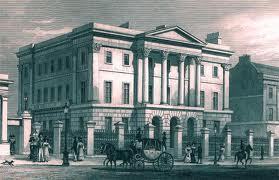 Apsley House
Apsley HouseFrom The Greville Memoirs
February 15th (1840) (Saturday).—The Duke of Wellington had a serious seizure on Thursday (1) He dines early, and he rode out after dinner. The first symptom of something wrong was, that he could not make out the numbers on the doors of the houses he wanted to call at. He went to Lady Burghersh, and when he came away, the footman told his groom he was sure his Grace was not well, and advised him to be very attentive to him. Many people were struck with the odd way he sat on his horse. As he went home this got more apparent. When not far from Apsley House he dropped the reins out of his left hand, but took them up with the other, and when he got to his own door, he found he could not get off his horse. He felt his hand chilled. This has been the first symptom in each of his three attacks. He was helped off. Hume was sent for, came directly, and got him to bed. He had a succession of violent convulsions, was speechless, and his arm was affected. They thought he would have died in the night. The doctors came, physicked but did not bleed him, and yesterday morning he was better. He has continued to mend ever since, but it was a desperate blow, and offers a sad prospect. He will probably again rally, but these things must be always impending, and his mind must be affected, and will be thought to be so. Lyndhurst asked me last night what could be done. He said, 'The Duke ought now to retire from public life, and not expose himself to any appearance of an enfeebled understanding. Above all things to be deprecated is, that he should ever become a dotard like Marlborough, or a driveller like Swift.' 'How,' he said, 'would Aberdeen do?' He owned that nobody could replace the Duke or keep the party in order, and he said that the consequence would be it would break up, that 'there are many who would be glad of an opportunity toleave it.' This I told him I did not believe, but it certainly is impossible to calculate on the consequences of the Duke's death, or, what is nearly the same thing, his withdrawal from the lead of the party.
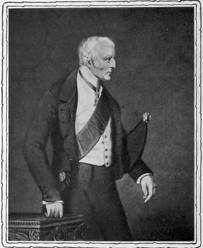
February 16th.—The Duke of Wellington, although his life was in such danger on Thursday night, that the chances were he would die, has thrown off his attack in a marvellous manner, and is now rapidly approaching to convalescence, all dangerous symptoms subsiding. The doctors, both Astley Cooper and Chambers, declare that they have never seen such an extraordinary power of rallying in anybody before in the whole course of their practice, and they expect that he will be quite as well again as he was before. It is remarkable that he has an accurate recollection of all the steps of his illness from the first perception of uneasy sensations to the moment of being seized with convulsions. He first felt a chillness in his hand, and he was surprised to find himself passing and repassing Lady Burghersh's house without knowing which it was. He called, however, and went up; and to her enquiry—for she was struck with his manner—he replied that he was quite well. Going home he dropped the rein, but caught it np with the other hand. When he arrived at his door, the servants saw he could not get off his horse, and helped him, and one of them ran off instantly for Hume. The Duke walked into his sitting-room, where Hume found him groaning, and standing by the chimney-piece. He got him to bed directly, and soon after the convulsions came on.
February 21st.—On Thursday morning I got a note from Arbuthnot, desiring I would call at Apsley House. When I got there, he told me that the Duke of Cambridge had sent for Lord Lyndhurst to consult him; that they were invited to meet the Queen on Friday at the Queen Dowager's, and he wanted to know what he was to do about giving precedence to Prince Albert. Lord Lyndhurst came to Apsley House and saw the Duke about it, and they agreed to report to the Duke of Cambridge their joint opinion that the Queen had an unquestionable right to give him any precedence she pleased, and that he had better concede it without making any difficulty.
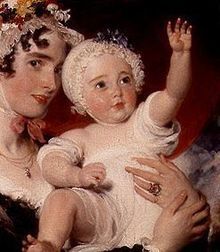 Wellington's niece, Priscilla, Lady Burgeresh, afterwards Lady Westmorland,
Wellington's niece, Priscilla, Lady Burgeresh, afterwards Lady Westmorland, holding her second son George Fane February 25th.—Yesterday I saw the Duke of Wellington, whom I had not seen for above six months, except for a moment at the Council just after his first illness. He looked better than I expected—very thin, and his clothes hanging about him, but strong on his legs, and his head erect. The great alteration I remarked was in his voice, which was hollow, though loud, and his utterance, which, though not indistinct, was very slow. He is certainly now only a ruin. He is gone to receive the Judges at Strathfieldsaye, and he will go on again when he comes back to town, and hold on while he can. It is his desire to die with the harness on his back, and he cannot endure the notion of retirement and care of his life, which is only valuable to him while he can exert it in active pursuits. I doubt if he could live in retirement and inactivity—the life of a valetudinarian.
March 12th.—The Duke of Wellington has reappeared in the House of Lords, goes about, and works as usual, but everybody is shocked and grieved at his appearance.
London, August 19th.—In the conversation at which Aberdeen told Clarendon this, he dilated upon the marvellous influence of the Duke, and the manner in which he treated his followers, and the language they endured from him. Clarendon asked him whether, when the Duke retired, he had any hopes of being able to govern them as well; to which he replied that he had not the slightest idea of it; on the contrary, that it would be impossible, that nobody else could govern them, and when his influence was withdrawn, they would split into every variety of opinion according to their several biases and dispositions. He said he did not think the Duke of Wellington had ever rendered greater service in his whole life than he had done this session in moderating violence and keeping his own party together and in order, and that he could still do the most essential service in the same way, and much more than by active leading in Parliament.
(1.) The Duke was seventy when he had this seizure, supposed at the time to be fatal, at least to his faculties. But he lived for twelve years more and continued during the greater part of that time to render great public services and to lead the Tory party.
Published on February 16, 2012 00:11
Kristine Hughes's Blog
- Kristine Hughes's profile
- 6 followers
Kristine Hughes isn't a Goodreads Author
(yet),
but they
do have a blog,
so here are some recent posts imported from
their feed.



